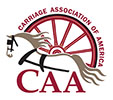During the late 1890s through to the early 1900s young men hitched their financial dreams to a peanut shaped wagon and a tandem of donkeys before heading for the beach. They were selling Peanutine, a peanut and molasses confection. Peanutine was commercially made by the E.B. Sears Peanutine Company in Old Orchard, Maine. The 1906 Maine Business Directory shows them in business and the Annual Report of the Bureau of Taxation shows lists their capital stock as $100,000 for the same year.
We primarily know about the business and their unique wagons through postcards. The Columbian Exposition of 1893, which spurred so many developments in the carriage industry, was also the birth place of postcards. With the passing of the Private Mailing Card Act in 1898, the postcard business boomed. Even then a peanut shaped wagon and tandem of donkeys wasn’t something seen everyday and thus many postcards of the combination were sold. Earl Brechlin, in Bygone Coastal Maine, says that the wagons were first pulled by dogs, then the donkeys before finally switching to horses. Postcards seem to be focused on the donkeys, a few pictures of the horses exist but, sadly, we have not been able to locate any of the dogs.

It is unknown exactly how many of these unique wagons were made. Thanks to the Biddeford Daily Journal , Nov 14, 1924, p. 14 we know that Freeman Dean, a local carriage maker, made at least one. The idea of creating uniquely shaped advertising vehicles seemed to offend other carriage makers as indicated in this quote from The Implement Age, Volume 38. “Some very grotesque delivery wagons are turned out nowadays,” said an Amesbury Mass carriage manufacturer. “Many owners wish something emblematic of the business they are engaged in. There are wagons shaped like bottles of patent medicines, like shoes, like hats, and like cigar boxes. There is a man in Old Orchard Maine whose business is the selling of peanut candy and he has a delivery wagon built in the shape of a large yellow peanut.”
Ultimately we do not know fate of the Peanutine wagons but their legacy lives on in postcards and photos. (Scroll down to learn about our adventures in making Peanutine.)

Making Peanutines

Jeff Morse found the recipe above and shared it with us, of course we had to try it! A few lessons learned along the way:
- Boxes of saltines were smaller back in the day, this recipe makes about a sleeve and a half.
- I bought raw peanuts for this recipe but roasted peanuts may be better.
- Premium brand saltine crackers are better than generic brand crackers for this recipe if you like your sweet with a bit of saltiness.
Overall though they were very good and disappeared fast! Definitely a recipe to consider adding to your summer picnic or tailgate.



Written by Kathleen Haak for the Carriage Association of America.
